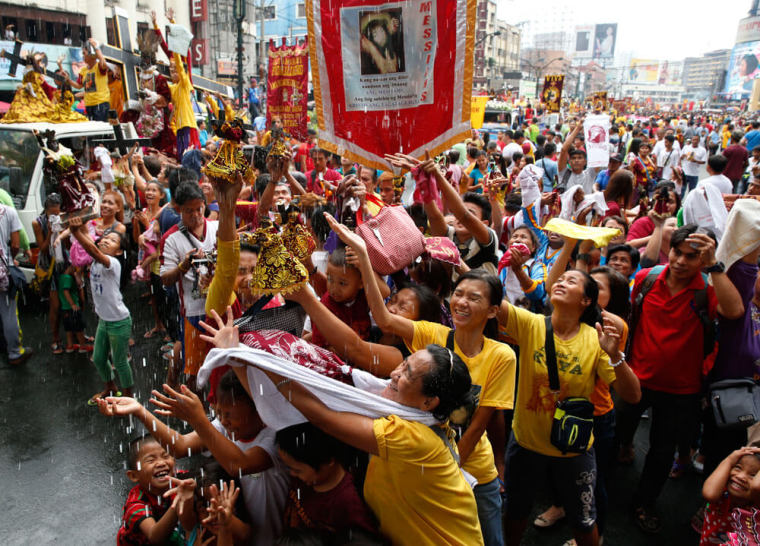1.5 Million Filipino Catholics Join Black Nazarene Procession Praying for Miracles


Get Our Latest News for FREE
"If family members get sick we would give them sponge baths with it [the towel or handkerchief]. That way we wouldn't spend money on doctors," a devotee, Dang Villacorta, was quoted as saying.
The Red Cross said at least one man died and 220 others were treated for wounds, dizziness and symptoms associated with low blood sugar, mainly due to exhaustion and as people in the crowd strived to get closer to the wooden statue of Jesus.
"The people reach out to it because they have a personal relationship with God," Monsignor Hernando Coronel, the parish priest of Quiapo, was quoted as saying earlier. "They come to me and say the Lord has performed miracles for them. To the devotees he is for real."
About 5,000 police officers and soldiers were deployed to secure the 20-hour procession, according to The Associated Press. Security personnel randomly checked bags for weapons, firecrackers and pointed objects, including umbrellas, which were banned.
The tight security was partly due to potential threats after the recent Paris attacks by the Islamic State terror group, also known as ISIS or ISIL.
About 80 percent of the population of the Philippines, which is one of the poorest nation of Southeast Asia, is Catholic.
The majority-Catholic nation has a high crime rate and the country's southern parts are ridden with Muslim extremism.
It is believed that the statue, which is crowned with thorns and bears a cross, was brought from Mexico to Manila by Spanish missionaries on a galleon in 1606. The ship carrying the statue at the time caught fire, but the charred statue survived.
The statue depicts Jesus bearing the cross en route to His crucifixion. Many devotees of the Black Nazarene believe their poverty and daily struggles are connected to the Passion of Christ as represented by the statue.
Was this article helpful?
Help keep The Christian Post free for everyone.
By making a recurring donation or a one-time donation of any amount, you're helping to keep CP's articles free and accessible for everyone.
We’re sorry to hear that.
Hope you’ll give us another try and check out some other articles. Return to homepage.
5 Million Join Philippines Jesus Parade Ahead of Pope's Visit; Two Dead, 1,000 Hurt
Manny Pacquiao Pays for 150 Homes for Homeless; Says Give God Thanks
Steve Harvey Says God Brought Him to Miss Universe Pageant; Celebs React to Blunder
Manny Pacquiao Says Miss Universe Avenged His Loss to Mayweather
Catholic Church Suspends Filipino Priest for Using Hoverboard in Christmas Eve Mass
Sponsored
Most Popular

Who has Trump picked for his cabinet? Here are 12 of his nominees

5 heartwarming movies to watch with family this Thanksgiving

Caitlyn Jenner threatens to 'destroy' Kamala Harris in California gubernatorial fight

Hal Lindsey, ‘Late Great Planet Earth' author, dies at 95

7 Thanksgiving controversies: Date change, mentions of God, ‘Day of Mourning’
More Articles

Elon Musk, RFK Jr. praise Trump's pick of Jay Bhattacharya for NIH director

Hal Lindsey, ‘Late Great Planet Earth' author, dies at 95

Texas lawmaker threatens university budget cuts over LGBT studies

'Focus on the gifts of God': Churches hold Thanksgiving Day worship services

Caitlyn Jenner threatens to 'destroy' Kamala Harris in California gubernatorial fight
















